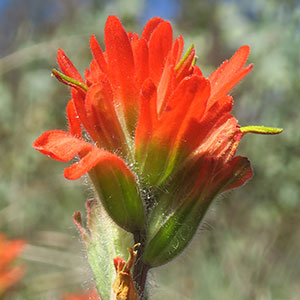Castilleja brevilobata
Castilleja victoriae
short-lobed paintbrush
Victoria owl-clover, Victoria paintbrush, Victoria's owl's-clover, Victoria's owl-clover, Victoria's paintbrush
solitary or few, erect or ascending, unbranched, sometimes branched, hairs spreading, short, medium, and long, soft, short and medium ones short stipitate-glandular.
solitary, erect, unbranched, sometimes branched, hairs spreading, long, soft, mixed with short stipitate-glandular ones.
green or ± yellow, lanceolate, elliptic, or oblong to narrowly ovate, 1–2(–2.5) cm, not fleshy, margins plane or wavy, involute, (0–)3–5(–7)-lobed, apex rounded to acute;
lobes ascending to erect, linear to lanceolate, apex rounded to acute.
usually brownish throughout, sometimes greenish proximally, brownish distally, margins deep brown, lanceolate to narrowly ovate, 0.5–2.7 cm, not fleshy, margins plane, involute, 0–3(–5)-lobed, apex acute;
lobes spreading-ascending, linear to lanceolate, apex acute, obtuse, or rounded.
3–20 × 2–3.5 cm;
bracts proximally greenish to dull brown, distally red, orange-red, or scarlet, sometimes orange or yellow, broadly lanceolate or oblong, (0–)3–5-lobed;
lobes ascending, broadly to narrowly lanceolate, short, arising above mid length, apex acute, obtuse, or rounded.
1–5 × 1.5–3 cm;
bracts dull reddish brown throughout, or proximally dull greenish, distally dull reddish brown, narrowly ovate, 3–7-lobed;
lobes ascending, lanceolate, medium length, arising near or above mid length, apex broadly acute or obtuse.
straight, 15–24(–26) mm;
tube 12–16 mm;
beak exserted, abaxial lip equal to calyx;
beak adaxially green or ± yellow-green, 7–10 mm, puberulent, stipitate-glandular;
abaxial lip deep green, reduced, rounded, 1–2 mm, 10–25% as long as beak;
teeth incurved to erect, light green, 0.5–1 mm.
straight, 10–18 mm;
tube 9–13 mm;
abaxial lip and beak exserted;
beak adaxially white, sometimes faintly diffuse purple, 3 mm, inconspicuously puberulent, hairs short stipitate-glandular;
abaxial lip yellowish, cream, or soft pale yellow, lacking spots, moderately conspicuous, pouches 3, conspicuous, 1–3 mm deep, central one furrowed, conspicuous, 2–2.5 mm, 60–75% as long as beak;
teeth erect, white or cream, 0.5–0.8 mm.
green or whitish with green veins, lobes colored as bract lobes or paler, 14–30 mm;
abaxial and adaxial clefts 5.5–8.5 mm, 30–40% of calyx length, deeper than laterals, lateral 1.5–4 mm, 20–25% of calyx length;
lobes oblong to narrowly triangular, apex obtuse to rounded.
colored as bracts, 8–12 mm;
abaxial and adaxial clefts 5–6 mm, 50% of calyx length, deeper than laterals, lateral 3–4 mm, 30–40% of calyx length;
lobes linear-lanceolate, apex acute.
included in beak.
= 24.
= 24.
Castilleja brevilobata
Castilleja victoriae
Castilleja brevilobata is endemic to dry serpentine openings in the Siskiyou Mountains of southwestern Oregon and adjacent California. Although sometimes treated as part of C. applegatei or C. hispida, its morphology does not suggest a close connection with either. This species occasionally hybridizes with C. pruinosa in Del Norte County, California.
(Discussion copyrighted by Flora of North America; reprinted with permission.)
Castilleja victoriae was first collected in 1893 but not described until 2008. It is restricted to the southernmost tip of Vancouver Island, near Oak Bay, and to several small adjacent islands within a 30 km radius in British Columbia and Washington. Its primary habitat is small depressions and vernal pools on gentle gradients within 100 m of the sea, making it particularly vulnerable to development and recreational conflicts. Never common, several historic populations near Victoria were extirpated before the species was recognized. The majority of the global population is found on Trial Island. All known extant populations would be inundated by projected sea level increases and storm surges due to climate change. It should be considered globally endangered.
(Discussion copyrighted by Flora of North America; reprinted with permission.)


